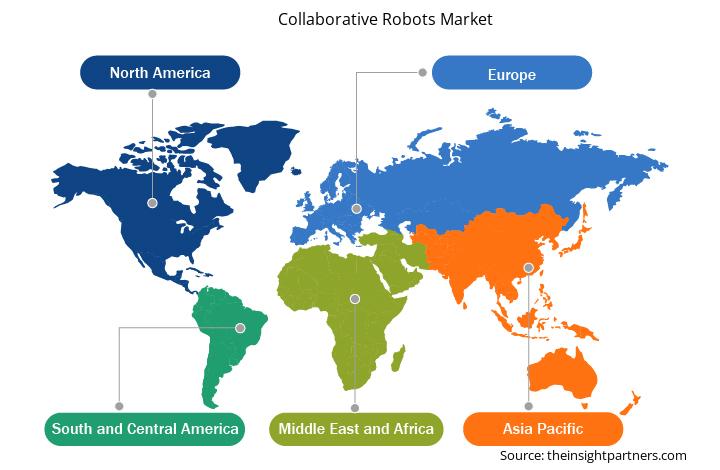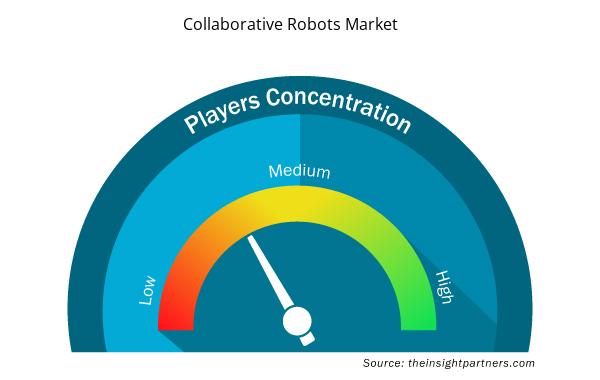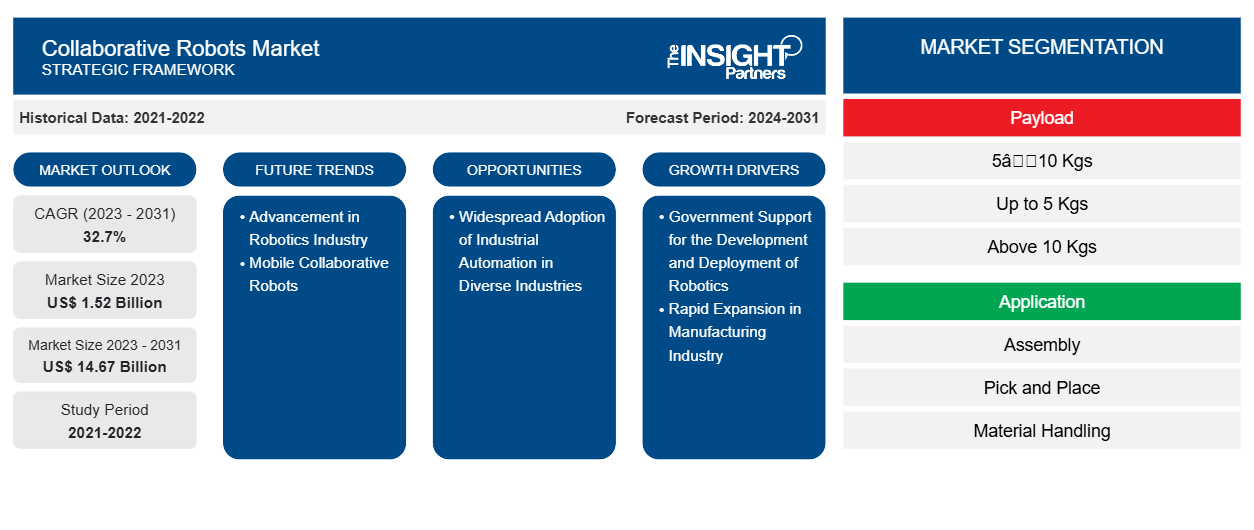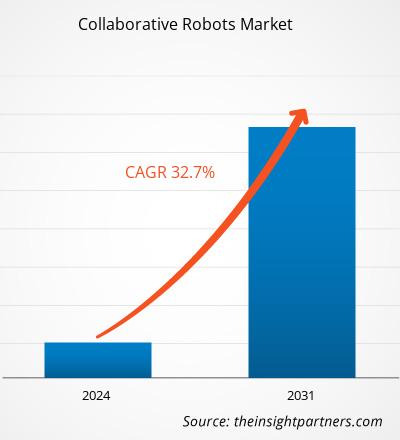協働ロボットの市場規模は、2023年の15億2,000万米ドルから2031年には146億7,000万米ドルに達すると予測されています。市場は2023年から2031年の間に32.7%のCAGRを記録すると予想されています。モバイル協働ロボットは、市場に新たなトレンドをもたらす可能性があります。
協働ロボット市場分析
協働ロボットは、マテリアルハンドリング、製造、研究室で使用されるサービスロボットのセグメントです。工場、特に人間とロボットがすでに調和して働き始めている製造部門での需要の増加により、協働ロボット市場が成長しています。協働ロボットの登場により、人間がロボットと安全に一緒に働くことができる信頼できる作業環境が実現しました。市場を牽引する主な要因には、ロボットの開発と展開に対する政府の支援と、製造業の急速な拡大が含まれます。
協働ロボット市場の概要
世界中のいくつかの国の政府は、それぞれの国でロボットの開発と採用を支援し、促進するための取り組みを行っています。政府によるこのような取り組みや措置は、産業用ロボットの市場成長を世界的に推進し、それによって協働ロボットの需要も高まると予想されています。2022年には、ヨーロッパが世界の協働ロボット市場で最大の収益シェアを占めました。ヨーロッパでは、堅調な自動車部門と大手高級車メーカーの存在が、協働ロボット市場を牽引すると予想されています。さらに、電気自動車製造の成長が市場の成長を牽引すると予想されています。
要件に合わせてレポートをカスタマイズする
このレポートの一部、国レベルの分析、Excelデータパックなど、あらゆるレポートを無料でカスタマイズできます。また、スタートアップや大学向けのお得なオファーや割引もご利用いただけます。
- このレポートの主要な市場動向を入手してください。この無料サンプルには、市場動向から見積もりや予測に至るまでのデータ分析が含まれます。
協働ロボット市場の推進要因と機会
ロボットの開発と導入に対する政府の支援
世界中のいくつかの国の政府は、それぞれの国でロボットの開発と導入を支援および促進するための取り組みを行っています。たとえば、シンガポール政府は、産業変革プログラムの一環として、企業のイノベーション、自動化、拡大を促進し、資金調達を行うためのいくつかの措置を発表しました。インド政府は、生産連動インセンティブ(PLI)スキームなど、インドでのスマート製造を促進するためのさまざまな措置を講じてきました。インドでの製造を促進するための政府の主要な取り組みとして、PLIスキームは2020年に開始され、自動車、医薬品、繊維、食品加工、白物家電など14の分野を対象としました。さらに、中国政府は、国内の製造部門で産業用ロボットを展開するためのいくつかの措置を講じてきました。これには、ハイテク産業の開発のための「中国製造2025」計画が含まれます。さらに、政府は、中国の産業用ロボット部門の拡大のために5年間の「ロボット産業開発計画」も発表しました。政府は、産業自動化に対してかなりの補助金と税制優遇措置を提供しています。さらに、ドイツのインダストリー4.0イニシアチブには、産業用ロボットの開発と導入が含まれています。政府は、2016年から2020年にかけて、人間とテクノロジーの相互作用の研究のために、研究機関、企業、学術機関を支援するために、毎年約7,800万米ドルの返金不可の現金助成金を提供することを発表しました。現在、自動化とロボット工学に関連する約300の研究プログラムが政府によって提供されています。
韓国政府は、2014~2018年の第2次知能ロボット開発基本計画として270万ドルの投資計画を発表しました。第2次基本計画(2014~2018年)の終了後、政府は第3次知能ロボット基本計画(2019~2023年)を策定し、実行しました。
多様な業界での産業オートメーションの普及
産業オートメーションの普及は、物流、食品・飲料、電気・電子、ゴム・プラスチックなど、自動車以外のさまざまな業界で増加しています。近年、自動車業界に比べて非自動車業界の普及は遅れていました。協働ロボットなどの機器の機能が向上するにつれて、非自動車業界での協働ロボットの採用がさらに加速すると予想されます。産業オートメーションの普及は、各国でも増加しています。中国、米国、日本などの先進市場では普及率が高くなっていますが、先進市場であっても、産業市場がさらに成長するチャンスはまだたくさんあります。これらの国の多く、特に自動車業界では、ロボットのさらなる導入の見通しが顕著です。この成長は、これらの市場で必要な近代化と変革に起因しています。これらの統計は、協働ロボットメーカーにとって有望であり、採用がさらに増加する大きな余地があることを意味しています。政府からメーカーへの相当な支援がある限り、低い普及率が予測期間中に大幅な成長を促進することが期待されます。
協働ロボット市場レポートのセグメンテーション分析
協働ロボット市場分析の導出に貢献した主要なセグメントは、ペイロード、アプリケーション、タイプ、エンドユーザー業界、および機能です。
- 積載量に基づいて、市場は5〜10kg、5kgまで、10kg超に分類されます。5〜10kgのセグメントは、2023年に最大の市場シェアを占めました。
- アプリケーションに基づいて、市場は組み立て、ピックアンドプレース、材料処理、品質テスト、マシンテンディング、溶接、パッケージングなどに分類されます。組み立てセグメントは2023年に最大の市場シェアを占めました。
- タイプ別に見ると、市場はロボットアーム、溶接ガン、グリッパー、その他に分類されます。ロボットアームセグメントは2023年に最大の市場シェアを占めました。
- エンドユーザー産業別に見ると、市場は自動車、電子機器、金属・機械、食品・飲料、物流、医薬品、その他に分類されています。2023年には自動車部門が市場を支配しました。
- 機能別に見ると、市場は静的ロボットと移動ロボットに分かれています。2023年には静的ロボットセグメントが市場を支配しました。
協働ロボットの地域別市場シェア分析
協働ロボット市場レポートの地理的範囲は、主に北米、アジア太平洋、ヨーロッパ、中東およびアフリカ、南米および中米の 5 つの地域に分かれています。
アジア太平洋地域は2023年に大きな市場シェアを占めました。アジア太平洋地域は、製造業で大きな成長を遂げている多くの発展途上国で構成されています。この地域は、多様な製造業が存在する世界的な製造ハブとなっています。中国が高技能製造ハブへと進化する中、インド、韓国、台湾、ベトナムなどの他の発展途上国は、低~中技能製造施設を人件費の安い近隣諸国に移転することを目的として、多くの企業を誘致しています。さらに、これらの国の政府は、製造活動を促進するための投資イニシアチブを奨励しています。しかし、熟練労働者の不足、生産性の低さ、発達したインフラの不足は、この地域の主要製造ハブとしての地位を強化するために対処する必要がある制約の一部です。
アジア太平洋地域の発展途上国の政府は、製造業がそれぞれの国に工場を設立するよう誘致するために、税金の還付、基金、補助金などの支援を提供しています。さらに、いくつかの政府は、Made in China 2025 や Make in India などの取り組みを行っています。しかし、最大の製造拠点である中国では、人口の高齢化により人件費が上昇しています。このため、製造業は東南アジア諸国への投資を求めています。インフラの改善、国内消費の増加、コストの低下は、これらの国に製造業を誘致する要因の一部です。
中国は世界最大の乗用車生産国です。アジア太平洋地域では、日本、インド、韓国も主要な自動車製造国です。自動車業界以外にも、中国ではいくつかの業界で協働ロボットが導入されています。たとえば、中国最大の浴室アクセサリーメーカーの 1 つである Xiamen Runner Industrial Corporation では、ユニバーサルロボットのロボット 64 台が生産ラインに導入され、成形機の手入れや製品の組み立てなど、さまざまな作業に使用されています。
協働ロボット市場の地域別分析
予測期間を通じて協働ロボット市場に影響を与える地域的な傾向と要因は、Insight Partners のアナリストによって徹底的に説明されています。このセクションでは、北米、ヨーロッパ、アジア太平洋、中東、アフリカ、南米、中米にわたる協働ロボット市場のセグメントと地理についても説明します。

- 協働ロボット市場の地域別データを入手
協働ロボット市場レポートの範囲
| レポート属性 | 詳細 |
|---|---|
| 2023年の市場規模 | 15億2千万米ドル |
| 2031年までの市場規模 | 146.7億米ドル |
| 世界のCAGR(2023年~2031年) | 32.7% |
| 履歴データ | 2021-2022 |
| 予測期間 | 2024-2031 |
| 対象セグメント | ペイロード別
|
| 対象地域と国 | 北米
|
| 市場リーダーと主要企業プロフィール |
|
協働ロボット市場のプレーヤー密度:ビジネスダイナミクスへの影響を理解する
協働ロボット市場は、消費者の嗜好の変化、技術の進歩、製品の利点に対する認識の高まりなどの要因により、エンドユーザーの需要が高まり、急速に成長しています。需要が高まるにつれて、企業は提供を拡大し、消費者のニーズを満たすために革新し、新たなトレンドを活用し、市場の成長をさらに促進しています。
市場プレーヤー密度とは、特定の市場または業界内で活動している企業または会社の分布を指します。これは、特定の市場スペースに、その市場規模または総市場価値に対してどれだけの競合相手 (市場プレーヤー) が存在するかを示します。
協働ロボット市場で事業を展開している主要企業は次のとおりです。
- クーカAG
- 安川アメリカ株式会社
- Aubo(北京)ロボティクステクノロジー株式会社
- 斗山ロボティクス株式会社
- ファナック株式会社
- ABB株式会社
免責事項:上記の企業は、特定の順序でランク付けされていません。

- 協働ロボット市場のトップキープレーヤーの概要を入手
協働ロボット市場のニュースと最近の動向
協働ロボット市場は、主要な企業出版物、協会データ、データベースなどの一次調査と二次調査後の定性的および定量的データを収集することによって評価されます。協働ロボット市場の動向のいくつかを以下に示します。
- オムロンは、複数の業界の多様な用途向けに設計されたオムロンTM Sシリーズの協働ロボットの提供開始を発表しました。これらの協働ロボットは、高度なハードウェア、より多くの安全機能と認証、次世代の構成機能を導入しており、これまで以上に使いやすくなっています。(出典:オムロン、プレスリリース、2023年9月)
- 国際的に有数の独立した第三者試験、検査、認証機関であるTÜV Rheinland Groupは、ESTUN Automation Co., Ltd.にESS(ESTUN Safety Solution)製品のCE機械指令および機能安全適合証明書を発行しました。これは、ESTUNが包括的なロボット機能安全製品システムの構築において急速に進歩したことを示しています。この認証は、ロボット技術分野におけるESTUNの革新力と専門レベルを証明するだけでなく、製品の安全性と品質に対する厳格な管理と取り組みを反映しており、世界市場でのESTUNのサービス品質と効率をさらに高めることになります。(出典:ESTUN Robotics、プレスリリース、2024年4月)
協働ロボット市場レポートの対象範囲と成果物
「協働ロボット市場規模と予測(2021~2031年)」レポートでは、以下の分野をカバーする市場の詳細な分析を提供しています。
- 協働ロボット市場規模と予測(世界、地域、国レベル)
- 協働ロボット市場の動向、および推進要因、制約、主要な機会などの市場動向
- 詳細なPESTおよびSWOT分析
- 主要な市場動向、世界および地域の枠組み、主要プレーヤー、規制、最近の市場動向を網羅した協働ロボット市場分析
- 協働ロボット市場の市場集中、ヒートマップ分析、主要プレーヤー、最近の動向を網羅した業界の状況と競争分析
- 詳細な企業プロフィール
- 過去2年間の分析、基準年、CAGRによる予測(7年間)
- PEST分析とSWOT分析
- 市場規模価値/数量 - 世界、地域、国
- 業界と競争環境
- Excel データセット


- Cell Line Development Market
- Radiopharmaceuticals Market
- Adaptive Traffic Control System Market
- Point of Care Diagnostics Market
- Virtual Pipeline Systems Market
- Advanced Planning and Scheduling Software Market
- Molecular Diagnostics Market
- Passport Reader Market
- Sodium Bicarbonate Market
- 3D Mapping and Modelling Market

Report Coverage
Revenue forecast, Company Analysis, Industry landscape, Growth factors, and Trends

Segment Covered
This text is related
to segments covered.

Regional Scope
North America, Europe, Asia Pacific, Middle East & Africa, South & Central America

Country Scope
This text is related
to country scope.
よくある質問
Teradyne Inc., Kuka AG, Yaskawa America Inc., Fanuc Corp, and ABB Ltd. are major players in the market.
The market is expected to reach a value of US$ 14.7 billion by 2031.
The market is anticipated to expand at a CAGR of 32.7% during 2023-2031.
Government support for the development & deployment of robotics and rapid expansion in the manufacturing industry are driving the market growth.
Advancements in the robotics industry and mobile collaborative robots are major trends in the market.
Trends and growth analysis reports related to Electronics and Semiconductor : READ MORE..
The List of Companies - Collaborative Robots Market
- Kuka AG
- Yaskawa America Inc
- Aubo (Beijing) Robotics Technology Co Ltd
- Doosan Robotics Inc
- Fanuc Corp
- ABB Ltd
- Rethink Robotics GmbH
- Techman Robot Inc
- Kawasaki Heavy Industries Ltd
- Bosch Rexroth AG
- Teradyne Inc
- Denso Corp
- Comau SpA
- SIASUN Robot & Automation CO., Ltd
- Agile Robots SE
- Azenta, Inc.
- Svaya Robotics Pvt. Ltd.
- Productive Robotics, LLC
- ESTUN AUTOMATION CO., LTD
- OMRON Corp
The Insight Partners performs research in 4 major stages: Data Collection & Secondary Research, Primary Research, Data Analysis and Data Triangulation & Final Review.
- Data Collection and Secondary Research:
As a market research and consulting firm operating from a decade, we have published and advised several client across the globe. First step for any study will start with an assessment of currently available data and insights from existing reports. Further, historical and current market information is collected from Investor Presentations, Annual Reports, SEC Filings, etc., and other information related to company’s performance and market positioning are gathered from Paid Databases (Factiva, Hoovers, and Reuters) and various other publications available in public domain.
Several associations trade associates, technical forums, institutes, societies and organization are accessed to gain technical as well as market related insights through their publications such as research papers, blogs and press releases related to the studies are referred to get cues about the market. Further, white papers, journals, magazines, and other news articles published in last 3 years are scrutinized and analyzed to understand the current market trends.
- Primary Research:
The primarily interview analysis comprise of data obtained from industry participants interview and answers to survey questions gathered by in-house primary team.
For primary research, interviews are conducted with industry experts/CEOs/Marketing Managers/VPs/Subject Matter Experts from both demand and supply side to get a 360-degree view of the market. The primary team conducts several interviews based on the complexity of the markets to understand the various market trends and dynamics which makes research more credible and precise.
A typical research interview fulfils the following functions:
- Provides first-hand information on the market size, market trends, growth trends, competitive landscape, and outlook
- Validates and strengthens in-house secondary research findings
- Develops the analysis team’s expertise and market understanding
Primary research involves email interactions and telephone interviews for each market, category, segment, and sub-segment across geographies. The participants who typically take part in such a process include, but are not limited to:
- Industry participants: VPs, business development managers, market intelligence managers and national sales managers
- Outside experts: Valuation experts, research analysts and key opinion leaders specializing in the electronics and semiconductor industry.
Below is the breakup of our primary respondents by company, designation, and region:

Once we receive the confirmation from primary research sources or primary respondents, we finalize the base year market estimation and forecast the data as per the macroeconomic and microeconomic factors assessed during data collection.
- Data Analysis:
Once data is validated through both secondary as well as primary respondents, we finalize the market estimations by hypothesis formulation and factor analysis at regional and country level.
- Macro-Economic Factor Analysis:
We analyse macroeconomic indicators such the gross domestic product (GDP), increase in the demand for goods and services across industries, technological advancement, regional economic growth, governmental policies, the influence of COVID-19, PEST analysis, and other aspects. This analysis aids in setting benchmarks for various nations/regions and approximating market splits. Additionally, the general trend of the aforementioned components aid in determining the market's development possibilities.
- Country Level Data:
Various factors that are especially aligned to the country are taken into account to determine the market size for a certain area and country, including the presence of vendors, such as headquarters and offices, the country's GDP, demand patterns, and industry growth. To comprehend the market dynamics for the nation, a number of growth variables, inhibitors, application areas, and current market trends are researched. The aforementioned elements aid in determining the country's overall market's growth potential.
- Company Profile:
The “Table of Contents” is formulated by listing and analyzing more than 25 - 30 companies operating in the market ecosystem across geographies. However, we profile only 10 companies as a standard practice in our syndicate reports. These 10 companies comprise leading, emerging, and regional players. Nonetheless, our analysis is not restricted to the 10 listed companies, we also analyze other companies present in the market to develop a holistic view and understand the prevailing trends. The “Company Profiles” section in the report covers key facts, business description, products & services, financial information, SWOT analysis, and key developments. The financial information presented is extracted from the annual reports and official documents of the publicly listed companies. Upon collecting the information for the sections of respective companies, we verify them via various primary sources and then compile the data in respective company profiles. The company level information helps us in deriving the base number as well as in forecasting the market size.
- Developing Base Number:
Aggregation of sales statistics (2020-2022) and macro-economic factor, and other secondary and primary research insights are utilized to arrive at base number and related market shares for 2022. The data gaps are identified in this step and relevant market data is analyzed, collected from paid primary interviews or databases. On finalizing the base year market size, forecasts are developed on the basis of macro-economic, industry and market growth factors and company level analysis.
- Data Triangulation and Final Review:
The market findings and base year market size calculations are validated from supply as well as demand side. Demand side validations are based on macro-economic factor analysis and benchmarks for respective regions and countries. In case of supply side validations, revenues of major companies are estimated (in case not available) based on industry benchmark, approximate number of employees, product portfolio, and primary interviews revenues are gathered. Further revenue from target product/service segment is assessed to avoid overshooting of market statistics. In case of heavy deviations between supply and demand side values, all thes steps are repeated to achieve synchronization.
We follow an iterative model, wherein we share our research findings with Subject Matter Experts (SME’s) and Key Opinion Leaders (KOLs) until consensus view of the market is not formulated – this model negates any drastic deviation in the opinions of experts. Only validated and universally acceptable research findings are quoted in our reports.
We have important check points that we use to validate our research findings – which we call – data triangulation, where we validate the information, we generate from secondary sources with primary interviews and then we re-validate with our internal data bases and Subject matter experts. This comprehensive model enables us to deliver high quality, reliable data in shortest possible time.


 このレポートの無料サンプルを入手する
このレポートの無料サンプルを入手する